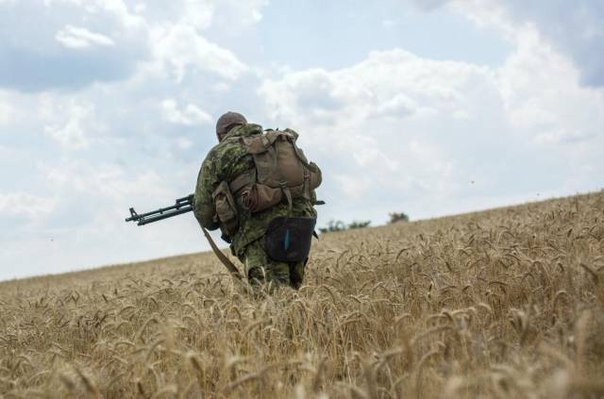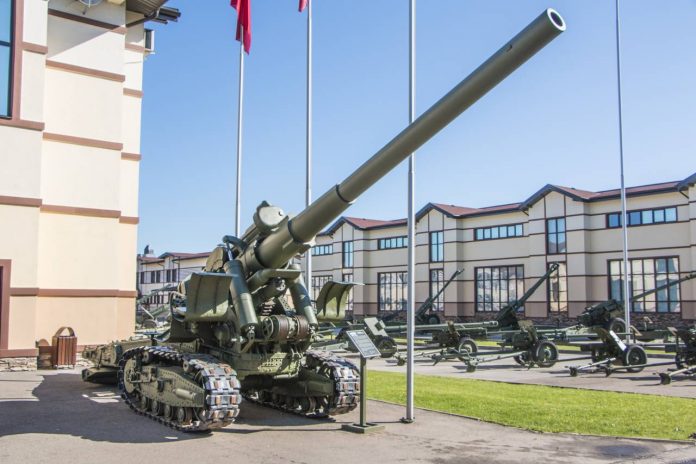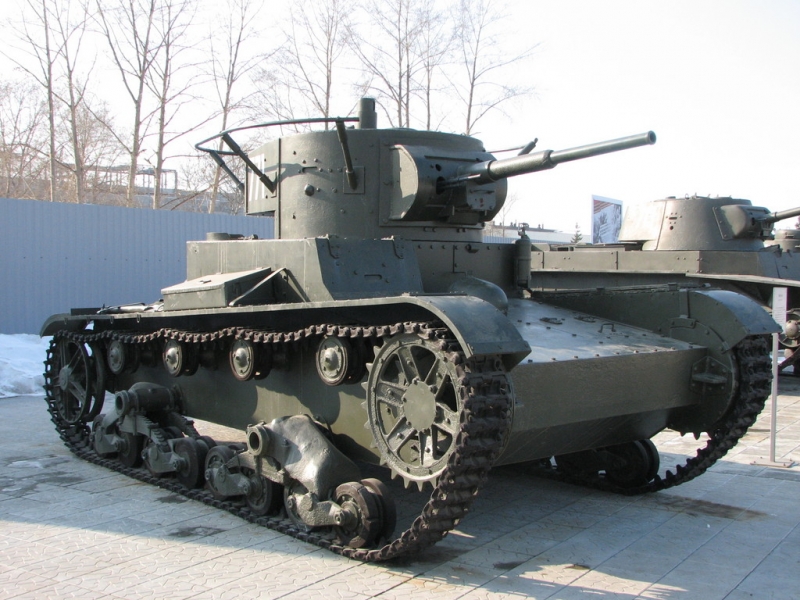
T-26 - Soviet light tank. It is based on "Vickers Mk.E» English tank (also known as "Vickers 6 ton"), zakuplennoho in 1930 year. Adopted in the USSR 1931 year.
T-26 – video
By the early 1930s, the Soviet Union tank fleet consisted primarily of mass light tank close support of infantry T-18, as well as different types of British machine during World War II. T-18 completed the task saturation of the Red Army fighting capacity and relatively modern machines, as well as the development of industry. However, the characteristics of T-18, It is a deep modernization of the French FT-17, by the 1929 year does not satisfy the requirements of the General Staff of the Red Army. At the end 1929 year at the board meeting GUVP concluded that, that in the absence of the Soviet tank designers proper experience and poor industrial base, development time of Soviet tanks and their specified performance characteristics are not maintained, and created projects are not suitable for mass production. Concerning 5 December 1929 by the Commission under the chairmanship of Mr. Narkomtyazhprom. Ordzhonikidze was decided to appeal to the foreign experience.
After getting acquainted with the experienced German tanks during the Soviet-German cooperation, as well as with other countries in the tanks during the study tour and the chief of the UMM. Khalepsky the US and Europe, started 30 December 1929 of the year, the output level of the backwardness of Soviet tanks was made.
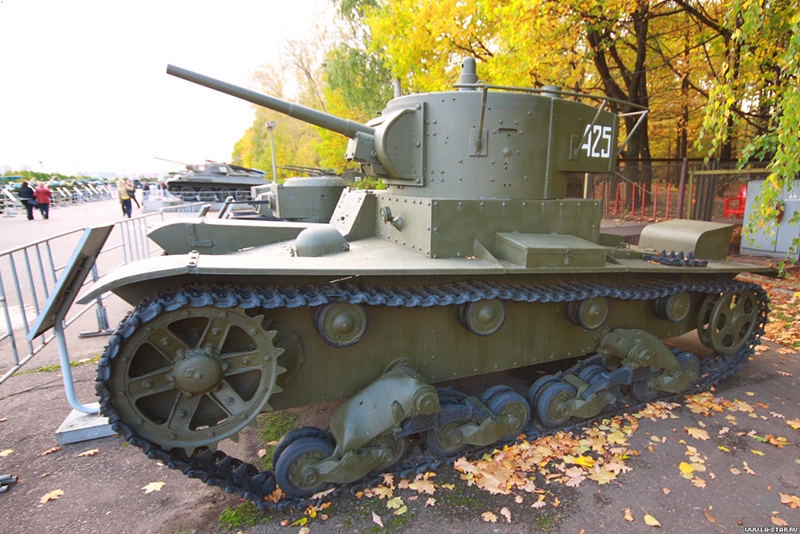
AT 1930 by purchasing commission headed was created. Khalepsky and Head of Engineering Design Bureau tanks with. Ginsburg, whose task is to select and purchase of tanks samples, tractors and cars, suitable for adopting Red Army. First of all, in the spring of Commission 1930 Year went to the UK, considers, in those years, the world leader in the manufacture of armored vehicles. Commission drew attention to light tank Mk.E or "6 tonne" (English. 6-your), created by "Vickers-Armstrong" in 1928-1929 and is actively offered for export. The Commission had planned to purchase only one copy of the necessary equipment, but selling single samples, and the more documentation, firm has refused, as a result it was agreed to purchase small lots of tanks, including - 15 Mk.E units at a price of 42 thousand rubles in the prices 1931 of the year, with a full set of technical documentation and licenses for the production of the USSR. Delivery of tanks had to be implemented from September 1930 January 1931 of the year. "Vickers-Armstrong" offers several options for the tank, in particular the "Model A» with twin towers with 7.7-mm machine guns "Vickers" and "Model B» double tower with a 37 mm cannon and snub 7.7mm machinegun, but the Soviets bought only two-tower machines. In the USSR Mk.E I received the designation B-26.
The assembly was carried out on the tank "Vickers-Armstrong" plants, in it, and Soviet specialists were involved to become familiar with the technology. The first B-26 was sent to the USSR 22 October 1930 of the year, until the end of the year in the USSR received three more tanks.
In the USSR, the first arrivals of the tanks arrived at the disposal "of the special commission on new tanks of the Red Army," under the direction of C.. Ginsburg, whose task was to select the tank for adopting Army. FROM 24 December 1930 year on 5 January 1931 In three years, 26 were tested in the area Poklonnaya Hill, on the basis of which the Commission had made "quite restrained 'conclusions. But in a January 8-11, showcasing two tanks in front of the representatives of the high command of the Red Army and the Moscow Military District, B-26 called them acclaim and is already 9 January was followed by an order to the. Voroshilov: "... finally solve the question of the expediency of organizing the production of B-26 in the USSR", and Ginzburg were ordered to submit a list of selected Narkomvoenmor during testing advantages and disadvantages of the B-26 as compared to the T-19.
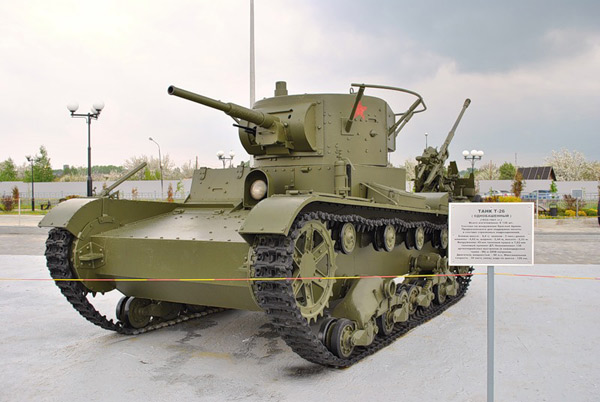
in the report, submitted 11 January 1931 of the year, concluded reliability and ease of transmission and running gear of B-26, and according to the requirements of these systems, the Red Army, but also stated, that the engine is unsuitable for mounting on a tank, and its design does not allow increasing the power of the traditional methods of speeding up. Among the advantages of the tank were also reported good optical sights of machine guns and easy to manufacture body shape, Among the shortcomings - no easy access to the engine and transmission, and the impossibility of carrying out routine maintenance of the engine in a fight inside the tank. In general, there, that "... the B-26, despite the disadvantages discussed, able to develop speed and agility, and is without a doubt the best example of all the currently known samples of foreign tanks ". Compared with T-19 was noted, that terms of performance and cost is the development of the most advantageous in the production of T-19, less - combined tank, juxtaposed nodes of T-19 and B-26 and least - an organization of production of B-26 unchanged. The general conclusions of the report referred to the need to begin designing a new tank based on the designs of T-19 and B-26, with motor, body and arms from the first, and transmission and chassis last, as well as joint tests of the T-19 and B-26 for more comprehensive results.
His project and suggested Wammen, which after reviewing the documentation for the B-26 offered to proceed to the design of the tank using the British design of the machine frame, but with reinforced armor and engine "Hercules" and "Franklin" capacity 100 l. from., the more suitable for the production conditions in the USSR. According to the results of the commission meeting on 16-17 January 1931 two years of technical tasks were issued: design group C. Ginzburg to create hybrid tank, known as the "T-19 improved" Wammen and the creation of "low power Tank" (TMM). for both projects work is progressing, in particular, conceptual design of the "T-19 improved" was adopted already 26 January of the same year, but adjustments to the plans made the international situation. So, 26 January and. Khalepsky sent a letter to Ginzburg, which it said, that, according to intelligence reports, Poland also conducts buying patterns, "Vickers» Mk.E and can, estimated leadership of the Red Army, By the end of this year, with the British and French help produce more 300 tanks of this type, that would give the Polish armored forces an advantage. In connection with this RVS Red Army considered it appropriate to consider the question of the immediate adopting B-26 in its current form. As a result,, 13 February 1931 the RVS, Khalepsky heard the report on the progress of the new tanks, decided to adopt B-26 Red Army adopted as a "main tank support portions and compounds-arms, as well as armored and mechanized units RGC "by assigning him the T-26 index.
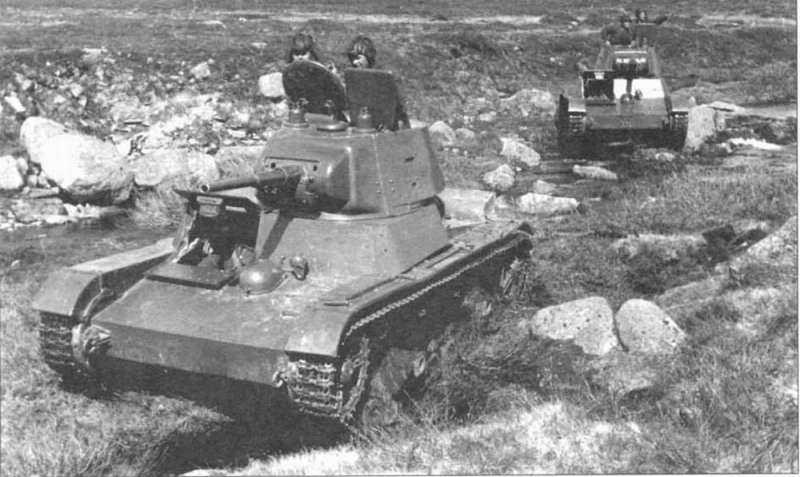
Mass production
For the production of T-26 in the absence of alternatives was chosen Leningrad plant "Bolshevik", Prior to doing the release of T-18. Later it supposed to be connected to the production and to finish building the Stalingrad Tractor Plant. Considered and Chelyabinsk Tractor Plant, It is also in the process of building. Design work on pre-production, and subsequently the tank upgrade, With supervised. Ginsburg. Initially, the plant "Bolshevik" was issued on the production plan 500 T-26 1931 year, later that number had been reduced to 300 with the release of the first tank within 1 May, but this figure could not be reached. Although plant previously produced similar rates of T-18, new tank proved to be much more difficult to manufacture. spring 1931 , the department of the plant, which consisted only of 5 human, prepared for production and produced two reference copies tank. TO 1 May the working drawings were completed, a 16 June approved the process and started production equipment for mass production.
In July 1931 the year began manufacturing the temporary installation technology (pre-production) party of 10 tanks with a non-armored housings, with extensive use of imported components. Machine design is exactly the same British original, differing only weapons, It consisted of the 37 mm gun FS-1 to the right tower and 7.62 mm machine guns DT-29 in the left. During production immediately revealed a number of serious problems, wherein, although the design office from the beginning of work repeatedly prompted to finalize the design, aimed at simplifying the manufacturing technology, All these attempts were stopped by the top management. Most of the problems brought tank engine, which the, Despite the seeming simplicity, He demanded a high production, than he could provide the Soviet plant - the first time it was considered normal, if a marriage of the engines is to 65 %. Besides, Ižorskomu Institute, Comes tank body, At first it was not possible because of the high percentage of marriage set up production of 13-mm armor plates, whereby a considerable part housings used instead of 10 mm. But 10-mm sheets are supplied in multiple housings have through-cracks and to test their way rifle 7.62 mm armor-piercing bullet from a distance of 150-200 m . Until November the hull produced from the assembly entirely on bolts and screws, to provide replacement armor plates conditionally. As a result, the initial batch of tanks, engines do not actually worked, and move the tanks could just interchange them with imported engine with standard B-26.
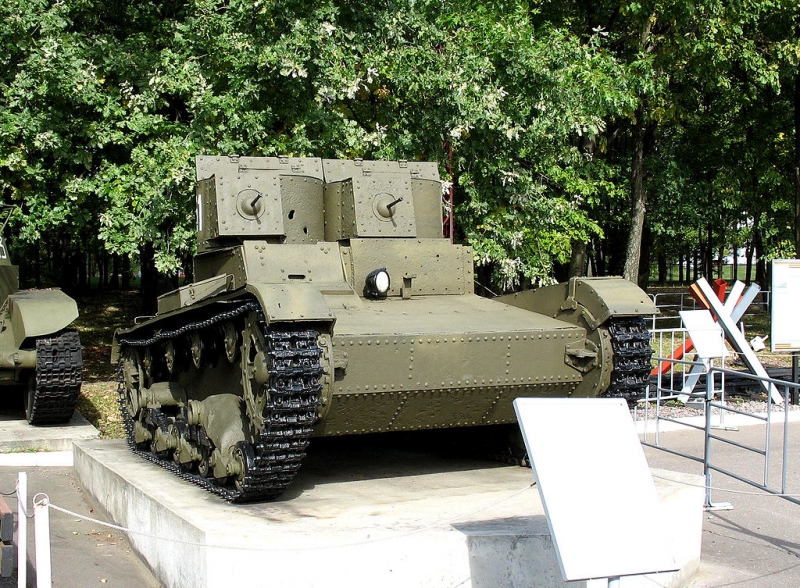
Serial production of two-tower tanks
In August 1931 the year began manufacturing the first production batch of 15 tanks, differing from the pre-production towers increased height with inspection hatches and slits in the top of the, better suited for production on the available equipment. But these engines were inoperable tanks, and to achieve the movement of tanks under its own power production was only in the autumn of the same year. Rushing to the development of production has led to, The plant to 1934 , it was not exactly set the process, tanks and costs almost twice the cost of manufacturing in the UK B-26. By the end 1931 year were made 120 tanks, but because of the poor quality of none of them initially failed to pass the military acceptance. Only after lengthy negotiations, the army agreed to accept, According to various sources, 88 or 100 tanks, moreover 35 one conditional, since they have a non-armored housing. Moreover, these tanks and the engine plant was ordered to replace, since when working under load "published multiple noises and interruptions experienced".
This situation led to the resumption of work on the T-19 and TMP, as well as the creation of a simplified small tank T-34, by which proposed to compensate for the lack of numerical support the tank in the event of the threat of war. Nevertheless, adopted in September 1931 year plan, providing for the issuance 3000 T-26 1932 year, was not corrected even after the, how to become a clear inability to join STZ while the production of. Only in February 1932 , the Defense Committee has allowed the plant to make any changes to the design of the tank, who "would not reduce the combat capabilities and contributed to an increase in output". Besides, for better organization of the work tank production at the plant "Bolshevik" was allocated in February in a separate plant number 174. The number of related companies by the end of 1932 has reached fifteen, These included: Ižorskij Bureau (armor hull and turret), "Red October" (gearboxes and cardan shafts), "Red Putilovets" (chassis), 'Bolshevik' (engine semi-finished products) and plant number 7 (boiler and sheet metal products). Besides, to the production of engines was planned to attract NAE and AMO. On a number of them with the production of such complex assemblies having problems, resulting in delayed delivery times of components, and the percentage of marriage, on the report of the director of the plant number 174 TO. Cirque of 26 April, He reached 70-88 % on engines and 34-41 % of body. As a result of the tank production plan was foiled again: by July, put the army was only 241 Tank In addition to taking in 1931 year, but only until the end of the year the plant was able to produce, According to various sources, 1341 or 1410 tanks, of which was brought to pass 1361, and accepted only 950.
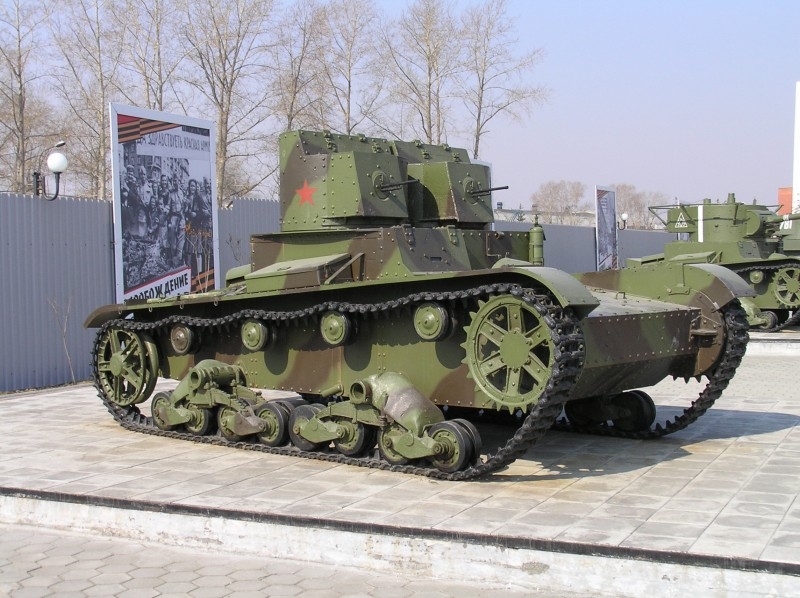
design of the tank during the production was constantly improved. In addition to the introduction of new towers, at 1931 the engine was pushed to the stern, to provide him with the best working conditions, and from the beginning 1932 , new fuel and oil tanks are introduced, and with 1 March of the same year, on the T-26 began installing duct on the outlet side bars, protects the motor from precipitation. FROM. Ginsburg also offered in March 1932 years go by the tilted front housing part, that would improve both manufacturability, The security and the tank, but this initiative was not supported. In January - March 1932 the party was released from 22 machines with welded housing, but due to lack of industrial base at the time the spread welding is not received. Nevertheless, in 1932-1933 gradually began to take welding in the construction of buildings and towers, wherein the housing could be placed in parallel as a welded construction and tselnoklopanoy, and mixed riveted, welded. on housing, regardless of structure, can be set as a riveted or welded, or mixed construction tower, And on one tank sometimes got different types of towers. From september 1932 the year was reinforced armor protection of the tank replacement 13-mm armor plates 15 mm.
T-26 riveted to the housing and the towers and machine-gun and gun arms
In parallel, two variants were produced tanks - with machine-gun armament and a machine-gun and cannon, consisted of gun DT-29 in the left tower, and 37mm cannon at right. Machine-gun tanks at the end of 1932 year was started with a ball mount for new guns DTU, but since the latter were soon removed from production, tanks of these series were unarmed and they later had to be replaced at the frontal towers are suitable for the installation of the old DT-29. On cannon tanks were installed 37 mm cannon Hotchkiss or its modified version Soviet "Hotchkiss-PS". but the release of these guns for arms folded and T-26 had to dismantle the gun with the withdrawal of combat units of T-18 and even the FT-17. More in preparation for the production of the T-26 arm assumed its more powerful 37-mm gun FS-2, but recent prototypes and have not been brought to a healthy state. Besides, FS-2 was large as compared with the PS-1 dimensions and length breech rollback and T-26 was assumed to install it in the middle of the tower experienced while the T-35. Another alternative was the cannon B-3, the resulting imposition of anti-tank gun barrel firm "Rheinmetall" on a bed of PS-2. work on it went more successfully, but in addition, due to the smaller B-3 can be fixed in a standard machine gun turret. Gun tests in a tank in the autumn 1931 year were successful, but the production of the B-3 unfolded much slower, than expected and T-26, they were only in small amounts, and in the summer 1932 , all produced by the guns of this type were to come into service BT-2 tanks. At the end 1933 year of the proposal M. Tukhachevsky worked over the installation in one of the towers of the tank 76-mm recoilless gun A design. Kurchevsky, but spent 9 Martha 1934 year trials have shown a number of shortcomings of such weapons - the total design nedovedonnost, inconvenience of loading on the move, formation behind the gun on firing jet hot gases, dangerous to the accompanying infantry - with the result that further work in this direction have been discontinued.
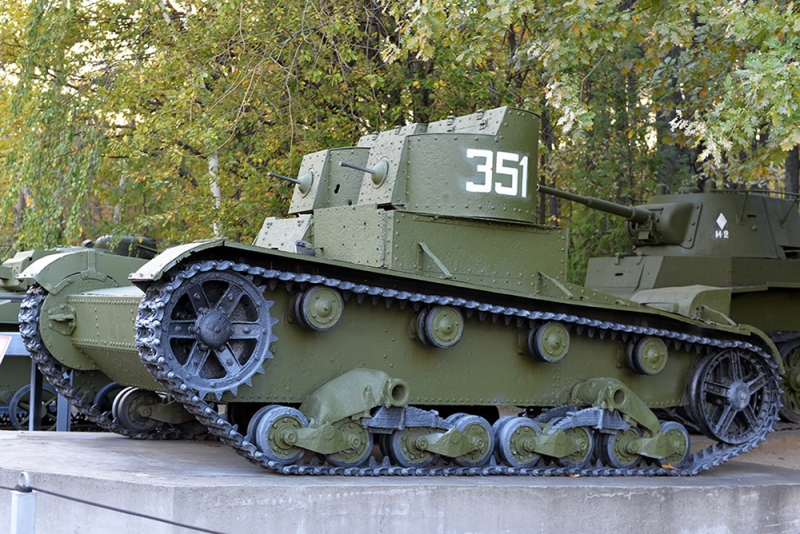
For better organization of tank production of the order of People's Commissariat 26 October 1932 Trust has been formed as part of a special machine building plant number 174, № 37, "Red October" and KhPZ. After getting acquainted with the situation in the factories, Trust management appealed to the Soviet government with a proposal to reduce the production of tanks for the program. The proposal was supported and endorsed at 1933 h Plant Plan number 174 should release 1700 tanks, and the focus should have been directed at improving the quality of the machines. But these plans were adjusted beginning of the release mono-tower version of the T-26 in the middle 1933 of the year. although M. Tukhachevsky advocated the continuation of the release two-tower machine gun machine, as the most appropriate for accompanying infantry, and the first time, both variants of the tank were produced in parallel, a mono-tower T-26 by the end of the year replaced its predecessor in production, and plans to release two-tower variant on 1934 year have been adjusted in favor of the release of specialized options, such as ognemotnye / chemical tanks. All the troops received, According to various sources, 1626 or 1627 two-tower T-26, from which gun-machine gun arms had about 450, including about 20-30 cars were armed with guns B-3.
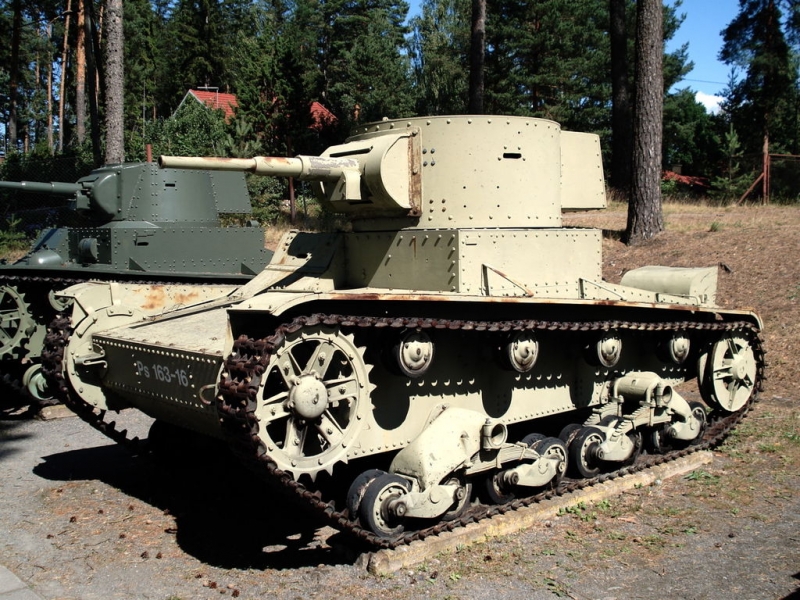
The transition to a mono-tower tank
Although of the proposed "Vickers-Armstrong» Mk.E options for serial production in the USSR was selected only two-tower machine gun, also in 1931 From year. Ginsburg has made allocation of funding for the creation of a "fighter tank" with the armament of 37mm cannon "great power" and 7.62-mm machine guns in twin installation, located in a single conical turret of the tank "T-19 improved". But the real work on the mono-tower T-26 began only in 1932 year. Development of a conical tower assembly of curved bronelistov be difficult for Soviet industry, therefore, the first tower of this type, Izhora Plants founded by the spring 1932 year and is intended for the tank BT-2, I had a cylindrical shape. A similar tower was assumed to install and version "fighter tank" T-26. At trial riveted and welded versions of the tower, preference was given to the first, which had been recommended for adopting a revised shortcomings and adding aft niches for the radio station. To conduct military trials Izhora plant was supposed to produce a batch of 10 towers, According to various sources, October 1932 or 21 January 1933 of the year.
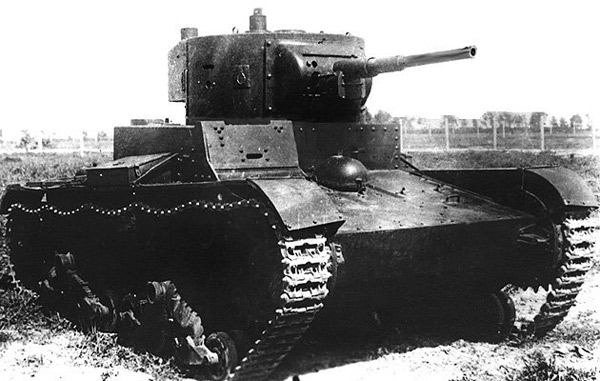
While they were working on the tower, also solved the issue of tank armament. 37-mm gun B-3 in September - October 1932 It has passed the tests in the new tower and was recommended to the adoption. But in May, 1932 year to replace the 37-mm anti-tank gun 45 mm gun mod was adopted. 1932 city, also became a candidate for tank weapons. In comparison with 37-mm cannon, 45-mm armor had close, but it is much more efficient fragmentation projectile at times more explosive charge. This made it possible to use a new tank, not only as a dedicated fighter, but replace the two-towered version, as a universal tank for infantry support. At the beginning 1933 , the design bureau of the plant number 174 twin installation 45-mm cannon and machine gun was developed, in March 1933 It has successfully passed factory tests. The main problem identified is part of a semi-automatic weapon failures, leads to the need for manual unloading, which significantly reduced the rate of. In February - March 1933 year comparative test B-3 and 20-K have been carried out, in which the two instruments showed similar results, except at the continuing refusal of semi-automatic 45 mm gun. Nevertheless, in the spring 1933 it was decided on adopting a mono-tower T-26 with 45-mm cannon. But the twin tower Izhora plant was deemed to be too close, and in the design bureau of the plant number 174 several options were developed increased volume, of which the direction of the UMM RKKA was selected cylindrical tower balanced riveted, welded construction, advanced stern niche oval, formed by the extension board sheets.
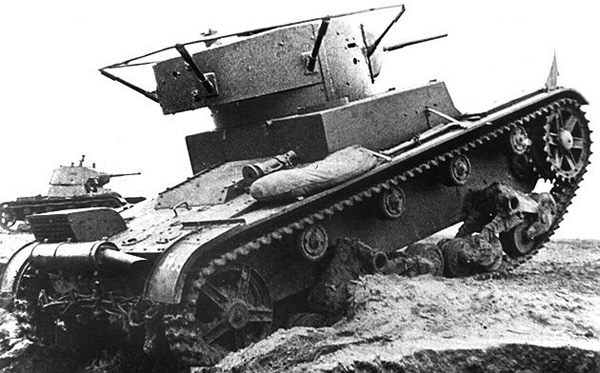
According to published in December 1932 , the decision of the Defense Committee, production of mono-tower tank was to begin with the 1601-series of T-26. Any difficulties with the transition to a mono-tower tank was not expected and planned to start its production already in the spring of 1933 of the year, but due to delays in deliveries of guns and scopes in the summer came to him. Besides the production of T-26 with towers plant design № 174, produces at the Izhora and Mariupol, a certain number of tanks and tower received a first embodiment with a small aft recess. According to some data, was the only party made such machines with towers of an experimental batch of the Izhora plant, number not more than 10-15 units, for the others - some, but also a slight, the number of T-26 tank turret received the type of number 230, Mariupol made to the BT-5 tanks. From the outset, the production of T-26 mono-tower designers plant № 174 I had to resolve a number of problems. One of them was, that the reliable operation of a mechanical semi-automatic gun 20-K to achieve and could not - according to the report of the director of the plant number 8, semi-automatic summer gave up 30 % bounce, and in the winter - "continuous failures". To address this, Special Design Bureau of Plant number 8 It introduced a new semi-automatic inertial type and modified recoil mechanisms. Modified mechanisms gun when firing shrapnel shells only worked as a ¼ Automation, providing a semi-automatic fire only armor-piercing projectiles, but the number of failures dropped to test 2 %. Serial production of a gun, received the designation "mod. 1932/34 years. ", It began in December 1933 years and up until the end of the T-26 it was without significant change of its basic armament.
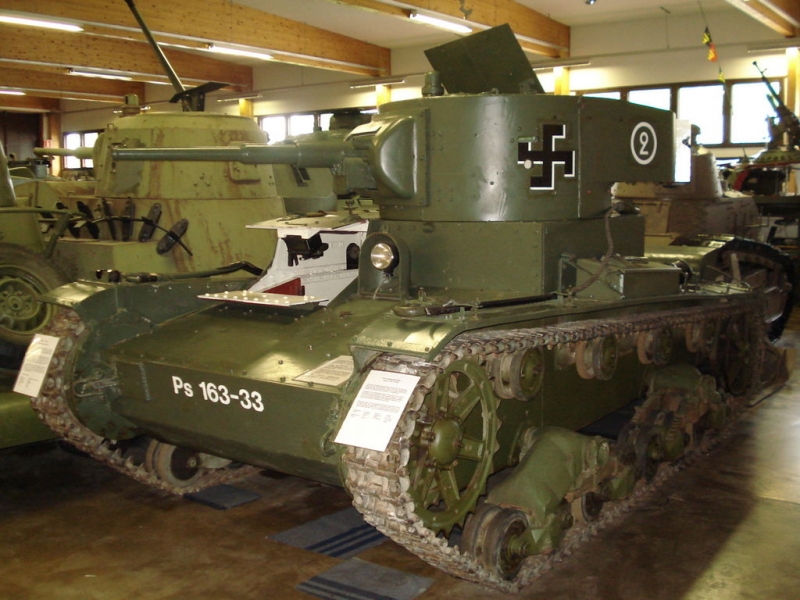
Trophy mono-tower T-26 with welded hull and turret and gun pressed mask, Finnish emblems (Tank Museum in g. password, Finland)
Another problem was the engine T-26, whose power, which stood at the time of 85-88 l. from., seems insufficient because ever-increasing weight of the tank, with the transition to a mono-tower modification will increase by ton. In the autumn 1932 the firm "Vickers-Armstrong" offered the Soviet side a modernized version of the engine power 100 l. from., but after studying its technical experts describe the plant number 174 it was proposed to hold a similar modernization of the engine on its own. expected, that the installation of a new carburetor will raise engine output up 95 l. from., However, an experimental batch of the modified engine testing showed their low reliability. To achieve satisfactory operation of the engine was only in May 1933 of the year, deforsirovan it up 92 l. from.. FROM 1933 year by the number 174, and subsequently pilot plant was conducted for the development of T-26 MT-4 output carbureted engine cooling air 200 l. from., as well as two-stroke or four-stroke diesel engine power DT-26 95 l. from., but the production started and has not been, Although the engine compartment from the tank 1934 , it was modified slightly to allow the installation of diesel.
Continued development of the tank and in other areas. Since the 45 mm gun when firing create an unacceptable concentration of carbon dioxide in the tank, from 1934 It has been introduced the fan on the right side of the roof of the crew compartment. In the years 1935-1936 was finally committed to a transition welded housing, and time-consuming to manufacture welded gun mantlet was with 1935 year replaced stamped. Of planned measures to enhance mobility, in addition to the development of the new engine include improved CPR and final drives, able to carry out only an increase in the power reserve, placed in the engine compartment additional fuel tank. Was introduced and a number of other changes, aimed at reducing production costs and improving operational reliability. From the end 1935 year T-26 start to install additional ball mount with a machine gun DT-29 in the aft turret plate, and some machine guns were equipped with telescopic sights instead dioptricalal. At the end 1935 year pivot antiaircraft machine-gun installation was designed for the tank still with the same DT-29, but the results of tests in the army it was considered inconvenient and mass production has not gone. Besides, from 1935 of the year, is based on every fifth tank, T-26 for combat operations at night were equipped with two guns fixed on the mask headlights, floodlights - the so-called "combat light headlights".
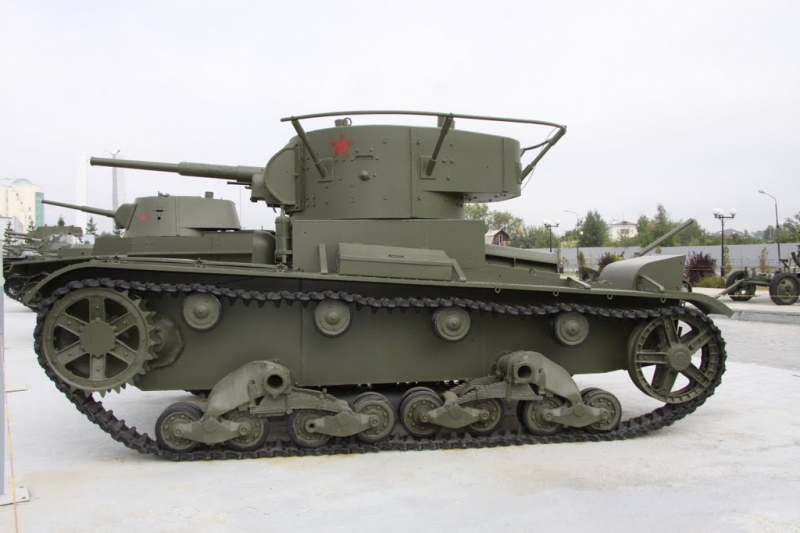
Mono-tower tank 71 with radio-TK
Production of T-26
Understand, how many T-26 was collected in reality, very difficult. But, using the Russian state archives documents, RGAE and RSMA, you can try to deal with this.
It is worth noting, that these figures included telemechanical group. At the moment, it is not possible to make them a separate line. known only, that in 1936-1937 produced 37 groups, In 1938-1939 - more 28. Besides, at the beginning 1941 of the year 130 two-tower tanks were converted to the mono-tower, by mounting them on towers of HT-133, but with a 45 mm gun.
AT 1940 year military leadership issued an order to two Leningrad plant - and the Kirov factory number 174 urgently establish a tank weighing about 14 t, armed with 45 mm gun and protected by armor moderate thickness protivosnaryadnym. Initially, the tank was registered under the name of T-126SP (JV - infantry support). Experienced his samples were created at the end of 1940 year and successfully tested. Preference is given to a tank factory number 174. somewhat later, in April 1940 It was issued a resolution on its acceptance by the Red Army and of setting in production at the factory number 174 under the designation T-50.
C 1941 It was expected to transfer the plant to the production of the T-50, therefore the production of T-26 tanks had to be stopped with 1 January 1941 of the year. However, production of tanks T-50 had problems, before the start of the Great Patriotic War the plant number 174 He did not release any serial tank of this type and in fact continued to produce the T-26. The most serious difficulties arose with the development of the diesel engine B-4 (Kharkov plant number 75).
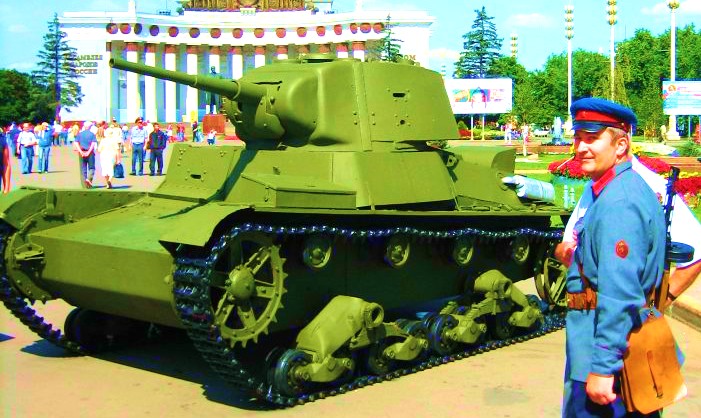
T-26 sample 1939 g. with the tapered tower and welded hull.
modifications
– T-26 sample 1931 g. - linear tank, two-tower version with machine-gun armament;
– T-26 sample 1932 g. - linear tank, two-tower version with a gun and machine gun armament (37-mm cannon in one of the towers and the gun in the other);
– T-26 sample 1933 g. - linear tank, mono-tower version with a cylindrical tower and a 45-mm cannon. The most massive version.
– T-26 sample 1938 g. - linear tank, mono-tower version with the conical tower and welded hull.
– T-26 sample 1939 g. - variant T-26 sample 1938 year with enhanced reservation. improved conical tower is also installed and turret ring box with sloping walls.
– T-26RT - mono-tower tank 71 with the radio-TK-1 (from 1933).
– T-26 TU (T-26 TU-132) - control a tank in a group telemechanical. manufactured 65 machines.
– T-26 TT (T-26, TT-131) - teletank in telemechanical group. manufactured 65 machines.
– T-26A - tank artillery support. installed a new, more spacious tower T 26-4 to 76-mm short-tank gun. produced by 6 prototypes.
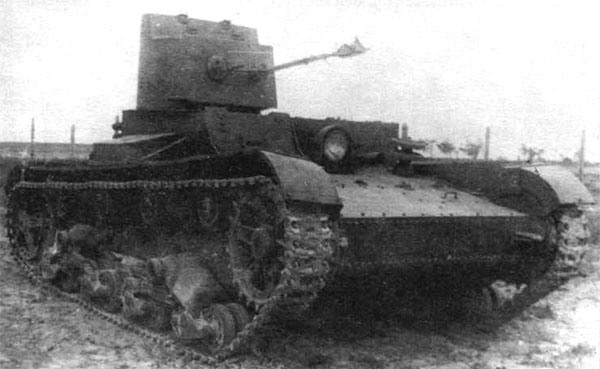
HT-26 chemical (ognemotny) tank
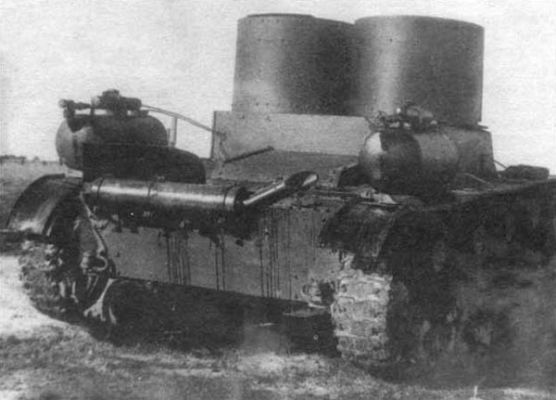
HT-26 chemical (ognemotny) tank. Modification of two-tower (back view)
– HT-26 - Chemical (ognemotny) tank, armature housed in a small tower. released 552 tank and 53 converted from serial 2 tower T-26.
– HT-130 - flame tank, model option 1933 of the year, flame thrower is mounted in the cylindrical tower instead of guns. made 401 a car.
– HT-133 - flame tank, model option 1938 of the year, flame thrower is mounted in a conical tower. produced by 269 tanks.
-HT-134 - flame tank, model option 1939 of the year. weaponry: 45-mm tank gun 20K sample 1932/38 gg., ognemotnaya installation in the housing, 2 machinegun DT, two prototypes released.
Last modification of the tank had to book 20 mm, and 45 mm specimen gun 1938 g. and a conical welded tower. Tanks with conical tower was manufactured 1975 units.
– T-26T ("Tractor T-26", "Tractor T-26") artillery tractor with canvas top. Rewritten of 2 tower tanks 151 a car. Further, to 1941 of the year, of the mono-tower rebuilt tanks More 50 units.
– T-26 variants with armored artillery tractor riding. Redone in tractors 10 a mono-tower tanks.
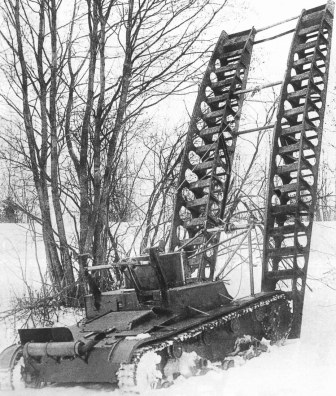
Mostoukladchyk CT-26
Design
T-26 has the arrangement with the placement of the engine compartment in the rear, transmission - in the frontal and combined crew compartment and driver's compartment - in the middle of the tank. T-26 formation. 1931 g. and arr. 1932 g. We had a two-tower arrangement, T-26 formation. 1933 g. and subsequent modifications - a mono-tower. The crew consisted of three people: on the two-tower - the driver, Left arrow towers and tank commander, also served as the right-hand tower; on a mono-tower - the driver, gunner and commander, also performs charging functions.
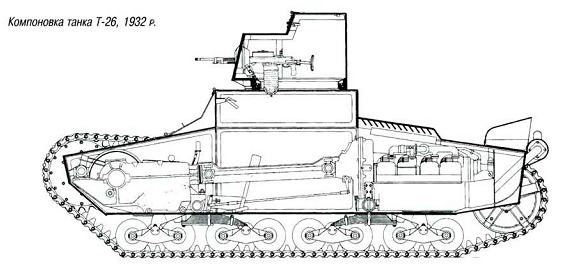
The arrangement of the T-26 (T-26 formation. 1931 g. and arr. 1932 g. We had a two-tower arrangement)
weaponry
two-tower modifications
Arming T-26 mod. 1931 g. were two 7.62-mm machine gun DT-29, are placed in the ball mount in the front part of the towers. Pointing guns was carried out using the rear sight. DT-29 has a range of effective fire in 600-800 m and a maximum effective range in 1000 m. Powered machine gun was carried out of the disk capacity in stores 63 chuck, the rate of fire was 600, and the rate of combat - 100 rounds per minute. Used for firing cartridges with heavy, armor piercing, tracer, armor-piercing tracer bullets and shooting tower. As in other Soviet tanks, Installation was quick-machine guns for use by the crew out of the tank, Why guns manned bipod. Ammunition guns was 6489 rounds in 103 shops.
In the two-tower T-26 machine gun with a gun-turret arms in the right instead gun was set 37 mm rifled gun "Hotchkiss' or B-3. The vast majority of the tanks were armed with guns, "Hotchkiss", and only a small part, 20-30 cars, established B-3. Cannon "Hotchkiss" was a barrel-piece length 22,7 caliber / 840 mm, vertical wedges, otkatnik hydraulic and spring recuperator. For aiming guns used telescopic sight optical MMP production, which had 2,45 × magnification and field of view of 14 ° 20 '. Rate "Hotchkiss" gun was to 15 rounds per minute. The gun was placed on the frontal part of the tower in horizontal journals and in the vertical plane, in the range of -8 to + 30 °, I suggest swing using shoulder rest. Guidance gun in a horizontal plane by turning tower.
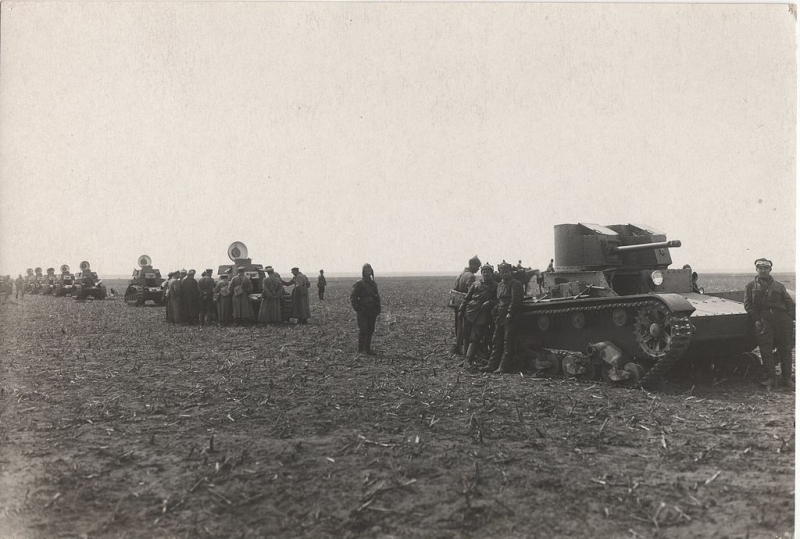
Two-towered gun and machine gun T-26 on the teachings of the 51st Division Perekopskaya near Odessa, 1932 year. In the background Column MS-1 tanks.
a mono-tower modifications
Main modifications arms mono-tower was 45 mm rifled gun semiautomatic arr. 1932 g. (20-TO), and with 1934 year - its modified version of the mod. 1932/34 gg. The gun had a barrel with a free tube, cemented casing, length 46 calibres / 2070 mm, vertical wedge gate with semi-automatic mechanical type on the gun arr. 1932 g. and inertsionnogo type of formation. 1932/34 gg. Recoil device consisted of hydraulic recoil buffer and spring recuperator, normal pullback length was 275 mm gun mod. 1932 g. and 245 mm for mod. 1932/34 gg. Semi-automatic weapon mod. 1932/34 gg. worked only when firing armor-piercing projectiles, whereas when firing shrapnel, because of the smaller length rollback, she worked as a ¼ Automation, providing only automatically close the shutter when inserting it into the cartridge, whereas the shutter opening and the extraction sleeve were made manually. Practical rate instruments was 7-12 rounds per minute.
tower arr. 1933 as the firing point Minsk fortified, KIC "Stalin Line"
The gun was placed in a twin with a machine gun installation, journaled in the frontal part of the tower. Guidance in the horizontal plane by turning tower with a screw rotating mechanism. The mechanism has two transmission, Turret rotation speed at which one revolution of the flywheel was gunner 2 or 4 °. Guidance in a vertical plane, with maximum angles from -6 to + 22 °, It was carried out using the mechanism of the sector. Guidance twin installation was carried out by means of a panoramic periscope optical sight PT-1 mod. 1932 g. and telescopic top arr. 1930 g. PT-1 was 2,5 × magnification and field of view 26 °, and its reticle was designed for firing at a range of 3,6 km armor-piercing projectiles, 2,7 km - fragmentation and to 1,6 km - from the coaxial machine gun. For shooting at night and in low light conditions sight supplied with illuminated scales and crosshairs. TOP was 2,5 × magnification, field of view 15 °, and an aiming reticle, calculated on the firing range of up to, respectively, 6,4, 3 and 1 km. FROM 1938 Year installed telescopic sight on the top of the tank 1 (OIL-1), stabilized in a vertical plane, with the same optical characteristics TOP. Sight supplied with collimating device, the oscillations in the vertical plane gun automatically expels the coincidence with the position of gun aiming line. shotgun formation. 1934 city, adapted for use with stabilized sight, designated as arr. 1938 g. Due to the complexity of the use and training of gunners, to the beginning of the Great Patriotic War stabilized sight was withdrawn from service.
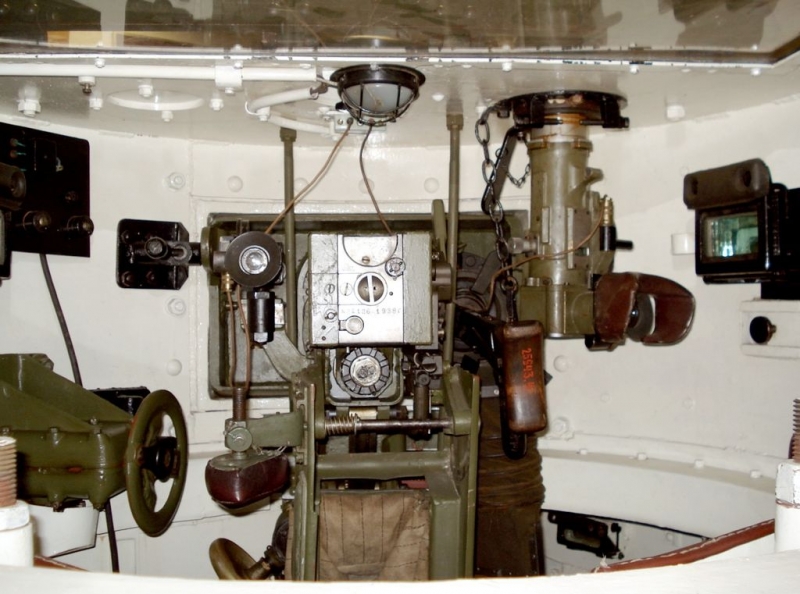
Tower T-26 mod. 1933 g. Visible breech 45-mm gun and its mechanisms aiming also coupled with the gun DT-29. Left of the gun sight is visible TOP, PT-1 panoramic sight dismantled.
observation and communication tools
Surveillance on the T-26, the first batch were rudimentary and driver's limited inspection hatches, and the commander and the arrow - the sights of machine guns. Only since the fall 1931 year were introduced open peephole in the hatch of the driver and increased tower height, in the upper part of which there inspection covers, the cover of which there were two peepholes.
The basic means of external communications at T-26 served as a warning flag, and all two-tower tanks had only her. On a part produced mono-tower tanks, receiving designation T-26RT, from autumn 1933 Year established radio station 71-TC-1 model. The share of PT-26 is only determined by the volume of supply stations, which are primarily equipped with the machine unit commanders, as well as part of the line of tanks. FROM 1934 It has been adopted for the upgraded version of the 71-TK-2, and with 1935 - 71-TK-3. 71-TK-3 was a special tank shorter simplex radio telephone and telegraph and had a working range of 4-5,625 MHz, consisting of 65 fixed frequencies, spaced through 25 kHz. Maximum transmission distance in a telephone mode is 15-18 km in motion and 25-30 km from the place, a telegraph - up 40 km; the presence of interference from the simultaneous operation of a plurality of radio stations, communication range could fall by half. The radio station had a mass 60 kg and a volume occupied by about 60 dm. For internal communication between the tank commander and a driver on the tanks earlier releases used by negotiations pipe, later replaced warning lights. On equipped with a radio station tanks 1937 , establishes tank intercom TPU-3 on all crew members.
The front bogie and driving sprocket downed T-26
Engine and transmission
GAS-T-26
The T-26 was installed in-line four-cylinder four-stroke petrol engine cooling air, It is a copy of the British "Armstrong Sidley Puma" and who had the designation "GAS T-26". The engine had a swept volume 6600 cm³ and a maximum power 91 l. from. / 66,9 kW at 2100 r / min and maximum torque 35 kg · m / 343 N · m at 1700 rev / min. In 1937-1938, a tank installed boosted engine option. According to some data, its capacity was 95 l. from., for the others - could range from 93 to 96 l. from. even on your passport. Forced fuel for gasoline engine serves 1st class, the so-called "Grozny". The specific fuel consumption was 285 g / l. s.ch.
The engine was located in the engine compartment along the longitudinal axis of the tank, feature of its configuration is the horizontal arrangement of cylinders. To the right of the engine in the engine compartment housed a fuel tank capacity 182 l, and the cooling system, Includes one centrifugal fan, housed in a casing of the engine. Since the mid 1932 year instead of one of the fuel tank on the tank began to be established two, capacity 110 and 180 liters.
The structure of the transmission T-26 were:
– Single disc master dry friction clutch (Stal on brake), mounted on the engine.
– Kardannыj Bhoomi, passed through the crew compartment.
– A five-speed (5+1) Three-way manual gearbox, placed in the control compartment on the left of the driver.
– swinging mechanism, consisting of two multi-plate clutch board springless type and band brakes with pads Ferodo.
– Single-stage final drives.
Chassis
Chassis T-26 for a board composed of eight doubles rubber rollers diameter 300 mm, four doubles rubber support rollers diameter 254 mm, idler and drive wheel front location. Suspension of rollers - interlocked in the Interchangeable carts on four, leaf springs. Each trolley consists of two rocker arms with two rollers, one of which is pivotally connected with a cast balance bar, in turn, is pivotally fixed to the tank body, and the other was attached to two parallel leaf springs chetvertellipticheskih, rigidly connected to the rocker. The only change in the suspension during the serial production of the tank was her gain 1939 year by replacing trohlistovyh springs pyatilistovymi, due to the increased weight of the tank. Track T-26 - width 260 mm, open metal hinge, odnogrebnevye, lantern meshing, those manufactured by molding from a chrome nickel manganese steel or.
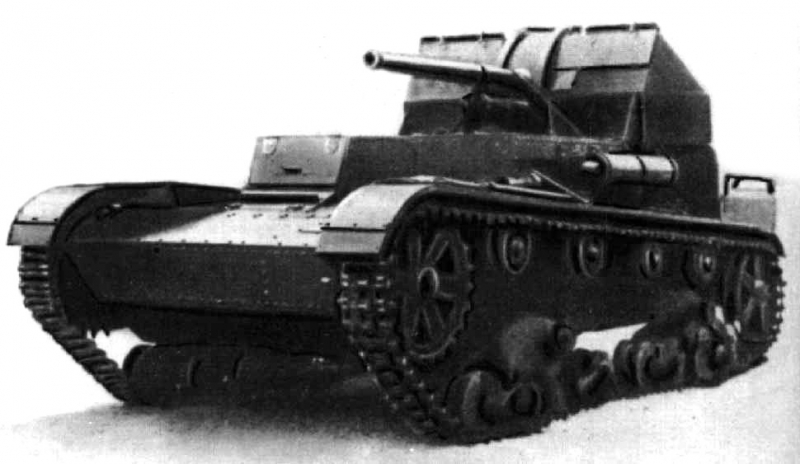
SAU SU-5-1
Machines based on the T-26
Self-propelled artillery
After adopting the T-26, on its base were moved earlier work on the creation of self-propelled artillery (HEALTHY), carried out on the basis of T-18 and T-19. In accordance with the decision of the Revolutionary Military Council of the USSR 1931 years of experimental weapons system, It planned to develop on the basis of the T-ACS 26 for mechanized:
– 76,2-mm cannon accompaniment, destined for the artillery preparation and support of tanks and as an anti-tank weapons;
– 45-mm anti-tank gun for antitank defense and tank support;
– 37-mm anti-aircraft automatic cannon for defense mechanized units on the march;
SU-1 It was developed by the design bureau of the plant "Bolshevik" issued by spring 1931 , the task to install the regimental gun on the chassis of the T-26. SAU was armed with 76.2-mm regimental gun mod. 1927 city, posted on the column book-rests installed in a fully enclosed armored cockpit of the fighting compartment, the level of protection appropriate to the base tank. ACS crew consisted of three people. The only prototype of the Su-1 was made in October 1931 and in November the same year passed the test. According to tests a schematic design performance was noted even some improvement in accuracy compared to the guns towed one, but were also noted serious shortcomings - the inconvenience of the crew in close combat compartment, lack boeukladok and defensive weapons. By decision of the UMM and GAU, after completion design SU-1 had to be released in a series of 100 units, but in May 1932 years of work on it was discontinued in favor of the artillery of the T-26-4.
More active work on a self-propelled artillery were deployed after the adoption of the SRT 22 Martha 1934 , the decision of re-Red Army artillery modern appliances.
SU-5, the so-called "small triplex" - family SAU, designed in 1934 Experimental Design Bureau, the plant Spetsmashtresta. All the machines are located on the family recompose the chassis of T-26, differs by transferring the engine compartment in the middle part of the body, to the left of the driver's compartment, and placing in the rear part of the housing half-open fighting compartment, armor protected only the front. Thickness reservation compared to the base tank was reduced - the case of sheets intended thickness 6 and 8 mm, and a protection of the crew compartment had a thickness 15 mm. SAU The crew consisted of the driver and four people gun calculation. All variants of the ACS differs only type instruments and related mechanisms. SU-5-1 was armed with a 76.2 mm gun mod. 1902/30 gg., SU-5-2 nesla 122-mm howitzer arr. 1910/30 gg., SU-5-3 and arming 152 mm mortar arr. 1931 g. (NM). Due to the lack of space to accommodate ACS needed ammunition provided for the use of armored Ammunition Carrier, also on the basis of T-26.
Prototypes of each of the ACS have been completed by the autumn 1934 year and 1935 year factory tested, accompanied by an intense refining designs. All three variants of the Su-5 were adopted, but are only 5-2 SU-entered serial production - from the SU-5-1 was abandoned in favor of the AT-1, and arming SU-5-3 was too powerful for the chassis T-26. According to some data, all were manufactured 6 SU-5-1 i 3 SU-5-3, on the other - only one sample of each. SU-5-2 already, in addition to the prototype, Was in 1936 year released a series of pilot 30 copies. Anticipated as a result of its military tests to finalize the design and to begin high-volume edition, but in 1937 , all work on the program SU-5 were phased out. Four SU-5-2 used the Red Army in the battle near Lake Hassan in 1938 year, and by the beginning of the Great Patriotic War, there were troops 28 ACS of this type, which were lost in the first week of fighting.
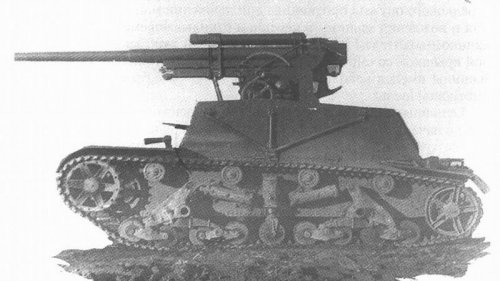
ZSU SU-6
SU-6 - ZSU the base T-26, KB also developed pilot plant in 1934 year. Arming SU-6 was 76-mm anti-aircraft gun semiautomatic arr. 1931 g. (3-TO), column book-rests placed on the installation in the middle of the tank, in the half-open fighting compartment, on the march to defend the flaps. For self-defense gun mount is equipped with two machine guns DT-29 in the front and aft folding sheets. Compared with the base tank, Corps SAU, bronelistov harvested from 6-8 mm, It has been increased, between bogies suspension is added additional roller with individual spring suspension, and the suspension of the entire hydraulic system introduced her lock when shooting[94]. AT 1935 , the prototype of the Su-6 was produced and passed the test, in which were numerous breakdowns and congestion installation, as well as insufficient stability during firing. As a result,, adopted SS6 was not accepted, but in October - December 1936 the year it was tested with a 37-mm automatic cannon design B. Hospital. production was begun four SS6 with armament, but tests 37-mm cannon revealed its numerous shortcomings, as a result, further work on the project had been terminated.
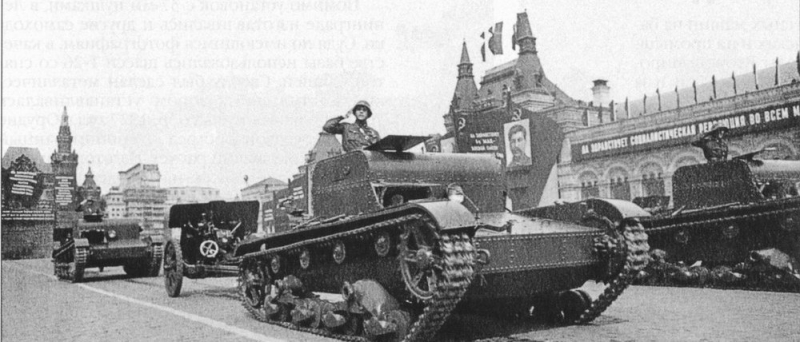
Tractor T-26T
tractors
Tractor T-26 variants have top open housing, and T-26T2 indoor. Several of these machines survived to 1945 of the year.
Armored
several armored personnel carriers has been created on the basis of T-26, who participated in the battles.
– TR-4 - bronetransportёr.
– TR-26 - bronetransportёr.
– TR-4-1 - conveyor ammunition.
– TV-26 - conveyor ammunition.
– TN-26 - a fuel transporter.
– T-26ts - fuel transporter.
chemical tanks
– CT (Chemical tank adjunct Schmidt) - a draft universal chemical tank, intended for the production of smoke screens, use of chemical warfare agents, degassing area and ognemetaniya. It was developed in the early 1930 gg. a team of designers led by adjunct Military Technical Academy of the Red Army Grigori Schmidt. The machine was a chassis T-26 instead of the established two towers cisterns (600 l. and 400 l.), body was slightly modified in connection with the installation of special equipment and the need for sealing. The project was not implemented due to non-compliant with the maximum uniformity of serial T-26.
– OU-T-26 - tank was developed by employees of Research Department Wammen them. Stalin led by F. I. Kotin in 1936 year, It differed from serial two-tower tank T-26, installation of an additional flame thrower.
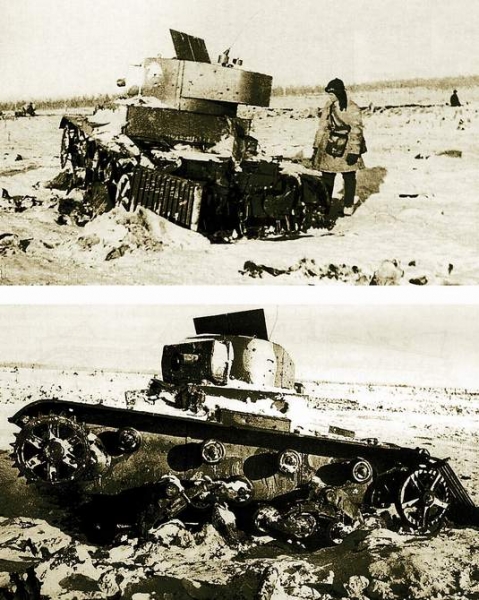
RC Tank CT-26 (217-th Independent Tank Battalion of the 30th Armored Brigade Chemical), February 1940 of the year
teletank
10 January 1930 the commander of the Leningrad Military District, Mikhail Tukhachevsky makes a report on the reorganization of the armed forces of the Red Army, People's Commissar for Military Affairs sea and Kliment Voroshilov the need for a remote-controlled tanks. Tukhachevsky acquainted with the work of the Bureau Bekauri, where to 1921 It has been developing radio-controlled weapons (initially it was radio-controlled planes), and I was fascinated by the idea of automation of military equipment. Tukhachevsky proposes to create several divisions of radio controlled tanks.
AT 1931 by Stalin was approved plan of reorganization of troops, in which bets are made on the tanks.
Group members
As part of the telecontrol Panzer Group had a pair of two tanks: tank management (TU), in which the operator performing radio control located in front within sight teletanks, which was no longer the crew; controlled from TU teletank. Total was in line 61 couple.
teletank (TT) and W represent a serial T-tanks 26 mounted thereon special equipment.
During the year, the tankers were trained in the use of CT-26. In addition to changing the motion vector, you can change the angle of rotation of the tower, manage flamethrower, make maneuvering a tank to fire conditions, let smokescreen.
Very soon these constructs was found "Achilles heel": one day, during the exercise, car suddenly lost control. After a thorough inspection equipment are no damages were found. A little later, it has been found, that the high-voltage power transmission line, passing near the teachings, cause harmful interference to radio. Also, the radio signal is lost on rough terrain, particularly when ingested large funnel, formed by the explosion of a shell
Modification of the "Squad" TT-TU
Telecontrol Group T-26, made in 1938 year. Composition: telemechanical tank with blow-off an explosive charge and control tank.
– Total weight with equipment: 13,5 t.
– The mass of the explosive device: 300-700 kg.
– distance control: 500-1500 m.
– weaponry: ognemёt and pulemёt DT.
Teletanks on the basis of T-26 have been used successfully in the Soviet-Finnish war in February 1940 of the year, in breaking the Mannerheim Line. It is known about the two episodes of undermining Finnish pillboxes on difficult areas. With the onset of World War II to improve teletanks development ceased, equipment with tanks were removed, tanks themselves and in the usual form sent to the front.
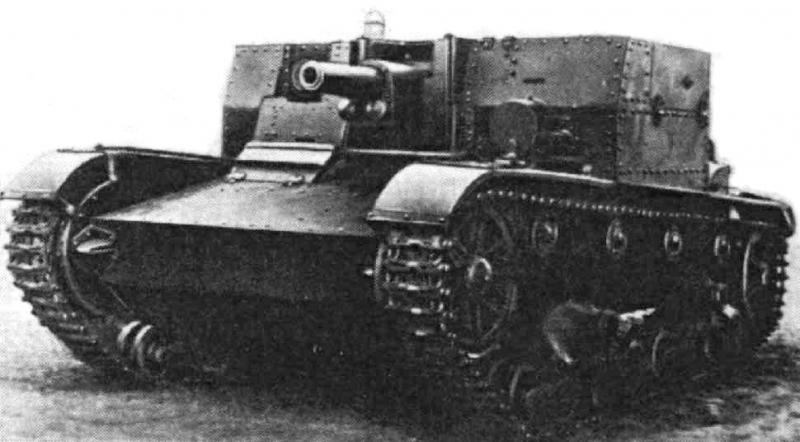
Artillery Tank AT-1
Release of armored vehicles on the chassis of the T-26
– TT-26 - teletank.
– TU-26 - Control Tank teletanks TT-26 in the composition of the group telemechanical.
– SU-5-1 - ACS with 76.2-mm gun (a small number).
– SU-5-2 - SAU are 122-mm gaubicej (a small number).
– SU-5-3 - SAU are 152.4 mm mortiroj (a small number).
– T-26 T - armored artillery tractor chassis-based T-26. An early version was insecure with tower, late T-26-T2 was completely armored. A small number of tanks was produced in 1933 year for motorized artillery battery, for towing divisional 76.2 mm guns. Some of them remained until 1945 of the year.
– TH-26 (Observer) - Experimental Observation version of the T-26-T, a radio station and crew 5 human.
– T-26FT - tank fotorazvedchik (fototank). The tank was intended for conducting film- and photo-reconnaissance, which it was possible including the move. Exploration was conducted through special holes for film- and photographic equipment in the tower. Tank gun had - it was replaced by the layout. The series has not started.
– T-26E - The Finnish army after the Finnish campaign 1940 Year tanks "Vickers Mk.E», perevooruzhonnye Soviet 45mm cannon, We are called T-26E. They were used in 1941-1944, and some remained in service until 1959 of the year.
– TR-4 - bronetransportёr.
– TR-26 - bronetransportёr.
– TR4-1 - conveyor ammunition.
– TV-26 - conveyor ammunition.
– T-26TS - fuel transporter.
– TTC-26 - a fuel transporter.
– ST-26 - Tank sapper (bridgelayer). produced from 1933 by 1935 year. Total collected 65 machines.
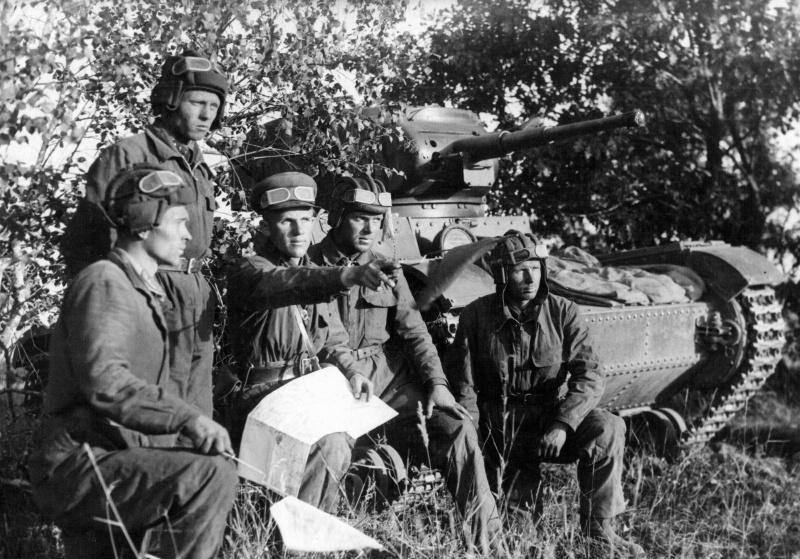
Tankers lieutenant H units. Bystrov on a reconnaissance of the area before fighting near Smolensk.
Leningrad plant experienced engineering number 185 On behalf of. M. Kirov. factory team had released a large number of armored vehicles specimens. Only on light tank chassis T-26 was designed more 20 models. Plant Design Bureau under the leadership of P. n. Syachintova pursuant to the decision of the Revolutionary Military Council of the USSR 5 August 1933 "The system artvooruzheniya Red Army to a second five-year plan" developed in 1934 the so-called "small triplex" (SU-5). It included three self-propelled artillery installation on standardized chassis of the tank T-26 - SU-5-1, SU-SU-5-2 and 5-3 - differing mainly weaponry. 152-mm mortar was installed on an experimental self-propelled artillery SU-5-3, created on the basis of the T-26. ACS has successfully passed factory tests at the end of 1934 of the year, Moreover, the experimental car was even sent to the traditional parade on Red Square. AT 1935 year, but, from its serial production was abandoned - tank chassis T-26 turned out to be not strong enough for normal operation of such a large-caliber gun. prototype fate unknown, according to some reports, he was transformed into a self-propelled guns SU-5-2 with a 122-mm howitzer arr. 1910/30 gg. AT 1933 the factory has started to design based on the T-26 tank artillery turretless AT-1 (self-propelled artillery installation of closed type), armed with a promising new 76-mm cannon PS-3. The tests took place in the tank 1935 year.
In accordance with the Resolution of SRT № 51 June 1933 Year "on the production of two prototypes of non-floating wheel-crawler type PT-1 tanks", at 1934 the factory produced two prototypes wheel-tracked tank, who received the name of T-29-4 and T-29-5. Prototype reference tank T-29 was manufactured in the factory 1935.
By mid-October 1935 T-26 tank was manufactured based self-propelled gun SU-6.
German ACS captured on the chassis T-26 (Then 97/38)
At the end 1943 Germans have established in the field 10 Pak guns 97/38 (Franco-German)chassis captured Soviet T-26. The resulting anti-ACS called 7,5 cm Pak 97/38(f) on Pz.740(r). New ACS entered into service third company 563rd antitank battalion. However, their military service did not last long - 1 Martha 1944 , they have been replaced by ACS Marder III.
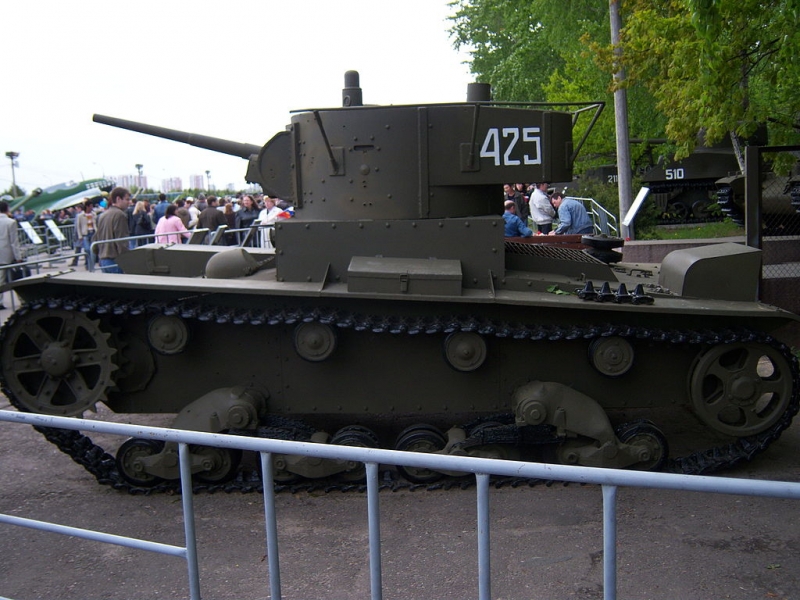
Tank T-26 with the radio station
Operation and use of combat
T-26 took part in the battles of the Civil War in Spain, at Lake Khasan and Khalkhin Goal, in the Polish campaign and the Soviet-Finnish War.
Along with BT, T-26 tanks formed the basis of Soviet tank fleet before the start of the Great Patriotic War and in its initial period. It should be noted, the tanks of T-26 was popular at one time, but the lack of coordination in the tank units (sometimes in the tank just did not have walkie-talkies) and slow-moving T-26 made him easy prey for enemy tanks. But there were a few tricks, typical for T-26, who turned it into a meat grinder at the forefront. Here's what we know from the chronicles[Source Unknown 2219 days]: "T-26, equipped with two towers, used as tanks fire support of infantry. Length (wheel) base was about 2 m. The width of the trenches, the infantry was about 50-70 cm. It is possible to use the T-26 in the first line of attack, and smooth out the enemy trenches. Tank BCTA of trench, I unfolded under the tower 90 degrees to the course, so that the right tower covered the right side of the tank, similarly for the left. Then Gunners were busy aimed fire on the infantry, prostrelivaya entire trench with one burst. "
One of the major drawbacks of two-tower models was, the arrows left and right from time to time interfere with each other to fire. With the advent of antitank rifles use of T-26 was more risky. Armor on the latest models made thicker and put a more acute angle (thought, it contributes to ricochet bullets and shells, which is not always rescued). In the mono-tower T-26 welded turret was shifted to the left. Cannon and machine gun mounted in twin installation, protected mantle result. Some of the tanks received an additional machine gun in the rear recess of the tower, which also can be installed as an anti-aircraft turret commander's hatch tower. But after upgrading the tank became heavier (thicker armor) and slightly lost in speed. When this book was bulletproof tank. Despite the weak armor protection, tank was tenacious because, the engine and the tanks located in the rear compartment of the cubicle. This tank was a record for that time ammunition - 230 37-mm shells, like armor, and incendiary.
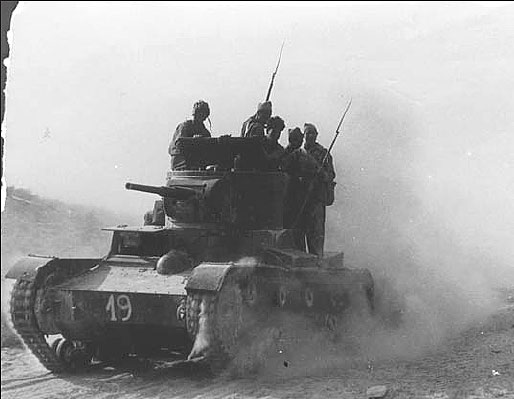
T-26 Republican 11th Brigade in the battle of Belchite, 1937. Tank T-26 mono-tower, Countdown. 1933 city, a cylindrical tower
The Spanish Civil War
Total has been sent to Spain 281 T-26
– 1936—106
– 1937—150
– 1938 — 25
During the Spanish Civil War, 29 October 1936 Osadchy year Semen on the T-26 was committed the world's first armored battering ram, pitting in the ravine Italian tankette "Ansaldo".
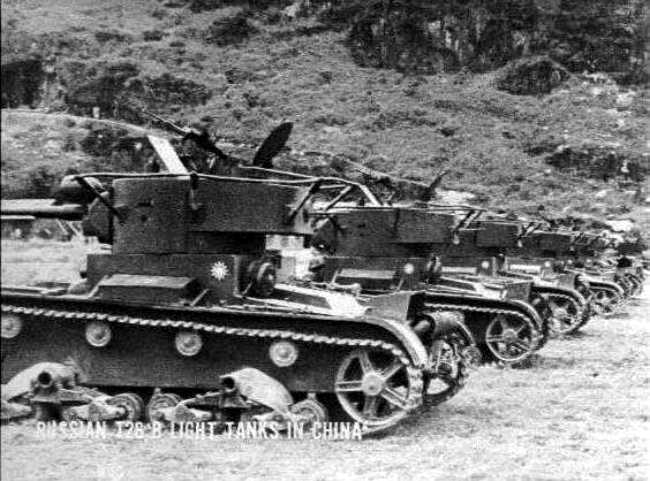
T-26 in China
Boi in Lake Hasan and Halhin-Gole
As has been lost during the fighting at Lake Khasan 77 T-26 are irretrievably 1 HT-26 and 10 T-26, wherein one T-26 of 40 th sel, missing in enemy territory, detected and has not been. Yet 2 tanks were destroyed in the fighting at Khalkhin Gol.
Soviet invasion of Poland
As has been irretrievably lost during the liberation campaign in Poland 10 T-26 with 45 mm cannon.
The Soviet-Finnish War
In the Winter War, the Red Army lost 23 2-x tower and 253 a mono-tower tanks.
The Great Patriotic War
– On the right flank, in no man's land, It moves us T-26, leading towing another, padded. Gun downed looking down, it feeds almost smokes. By slowly crawling tug fast approaching enemy tank. He goes to him severely in the head, and in the distance behind him stood several other German cars. I understand his maneuver: hiding behind a black, towed tank, it tends to come closer, to then, turning aside, Shoot stride towing machine. From the tower tug one after the other two fall out. After jumping from the stern to towed tank, they disappear in the open hole of the driver's hatch. Cannon destroyed tank trembled, He rose toward the pursuer and double flash of flame. German tank tripped and stopped ...
- From the memoirs of Mr.. Penezhko, Hero of the Soviet Union
The most extensive use of tanks of this type was in the Winter War, the Finnish front in 1940 year, as well as at the beginning of the Great Patriotic War 1941 year. T-26 tanks were the most abundant in the Soviet Army in the Great Patriotic War. In the first months of the war, most of these tanks (along with other tanks, more advanced models) it was lost. As of 28 October 1941 years on the Western Front had 441 tank, of them 33 KB-1, 175 T-34, 43 BT, 50 T-26, 113 T-40 32 T-60. Last time the T-26 was used in 1945 year against the Kwantung Army in Manchuria.
Evaluation of the project
BT series tanks and T-26 tank fleet formed the basis of the Red Army in the late 1930s. The armor protection of the T-26 was designed for a maximum of resistance to rifle bullets and shell fragments. In the same time, Armor T-26 easily thrust itself armor-piercing rifle bullets with distance 50-100m. Therefore, one of the directions of development of the Soviet tank building was a radical increase armor of tanks from the fire the most massive anti-tank weapons.
The Spanish Civil War, which participated actively put republican government light tanks T-26 and BT-5, He demonstrated all the growing role of anti-tank artillery and its saturation in developed countries armies. Thus the basic anti-tank weapons become not anti-tank guns and heavy guns, a rapid-caliber guns 25-47 mm caliber. that, as the practice, easy to destroy tanks with anti-bullet armor, and defense breakthrough saturated such instruments could cost big losses in armor. Analyzing the development of foreign anti-tank weapons, chief designer of the plant number 174 FROM. Ginzburg wrote:
– Power and rate modern anti 37mm cannon is sufficient, to make an unsuccessful attack company tonkobronnyh tanks, producing in line platoons, provided that 1-2 of anti-tank guns 200-400 m defense front ...
Already at the beginning 1938 , Soviet military realized, that the T-26 began to rapidly become obsolete, With that, it was noted. A. Ginzburg still one and a half years earlier. TO 1938 , the T-26, still surpass foreign cars on arms, I began to give way to them by other parameters. Primarily marked weakness reservation and insufficient mobility of the tank in connection with the small motor capacity and congestion suspension. Furthermore, trends in world tank building development at that time were as follows, that has the T-26 in the near future could lose their advantage and the latest in weaponry, that is the beginning of the 1940s. become completely obsolete. The Soviet leadership in 1938 It was finally decided to develop new types of tanks with protivosnaryadnym reservation and finally stop the modernization of outdated T-26 and BT.
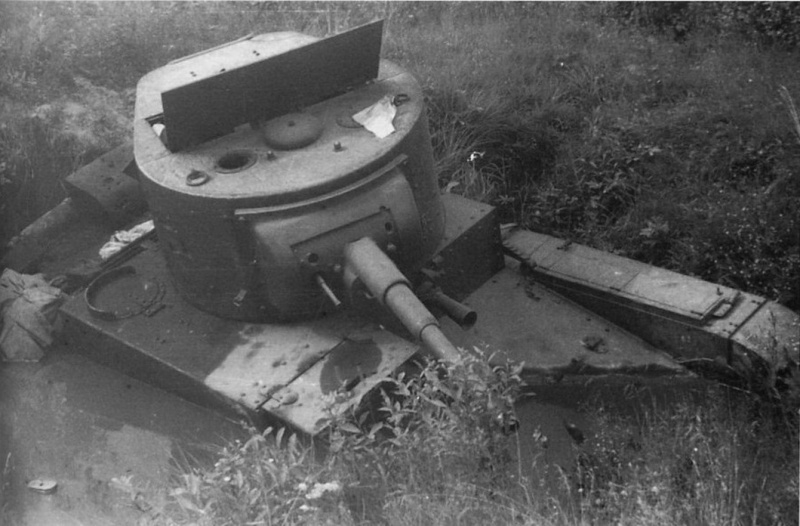
Stuck in a swamp and abandoned Soviet light tank T-26. According to the characteristic features, Machine Release year 1936-1937.
On 22 June 1941 in the Red Army, there were about 10 thousands of T-26. poor (bulletproof) book and the low mobility of the tank was one of the factors, leading to low efficiency of the use of these tanks in the initial period of the Great Patriotic War. Nevertheless, It should be noted, that the book most German tanks and self-propelled guns of the time was, in its turn, vulnerable to 37- or 45mm guns T-26. Most of the T-26 was lost by the Soviet side in the first six months of the war.
Suffice it a significant part of the losses of armored forces of the Red Army in the summer 1941 years wore non-combat character. Service engineering staff due to the outbreak of war, It was not called in part of material support of tank units. It is also not been transferred to the tractor RKKA evacuation equipment and fuel. Worn old tanks T-26 and BT together with unreported T-34 and KV during sverhforsirovannyh marches broke and threw themselves on the territory seized by the enemy, as a result of profound breakthroughs Wehrmacht some tanks were captured even on railway platforms - they did not have time to upload to join the fight or evacuate to the rear for repair. The defeat of the Red Army in the first period of the Great Patriotic War, some observers have attributed low-skilled senior and middle command staff. According to the interrogation taken prisoner by Senno former commander of the howitzer battery the 14th Armored Division, I. AND. Dzhugashvili:
– The failure of the Soviet tank forces not due to the poor quality of materials or weapons, and inability to command and lack of experience maneuvering. The commanders of brigades, divisions, corps, unable to solve operational problems. Especially it concerns the interaction of different types of armed forces.
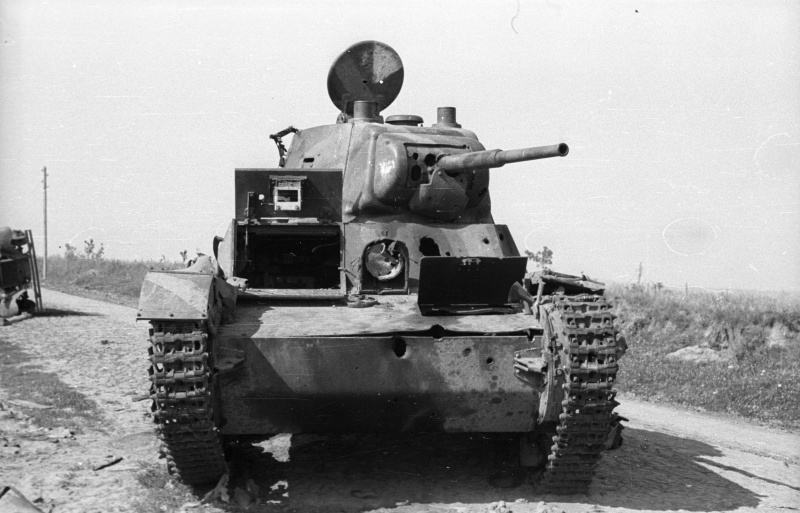
Soviet tank T-26, lined on the road under the Kamenetz-Podolsk
Performance characteristics of the T-26
Crew, pers.: 3
years of production: 1931—1941
years of operation: 1931—1960
The number of issued, PC.: 11 218
The layout: two-tower
Weight T-26
– 9,65 tonnes (wood. 1936 city)
Dimensions T-26
– body Length, mm: 4620
– housing width, mm: 2440
– Height, mm: 2190
– Clearance, mm: 380
Bumper T-26
– Type broni: steel rolled homogeneous
– housing forehead, mm / city.: 15
– body board, mm / city.: 15
– housing feed, mm / city.: 15
– Bottom, mm: 6
– corps roof, mm: 10
– tower forehead, mm / city.: 15
– gun mantlet, mm / city.: 15
– board towers, mm / city.: 15
– tower feed, mm / city.: 15
– tower roof, mm: 6
Arming T-26
– Caliber guns and stamp: 45-mm 20K
– barrel length, calibres: 46
– Shotgun: 2 × 7,62-mm DT
Engine T-26
– engine's type: inline 4-cylinder air-cooling Carburetor
– Engine power, l. from.: 90—91
The rate of T-26
– Road speed, kmh: 30
– Cruising on the highway, km: 120
– suspension type: interlocked by four, leaf springs
– Gradeability, city.: 40°
– to overcome the wall, m: 0,75
– trench, m: 2,0
– fording, m: 0,8
Photo T-26
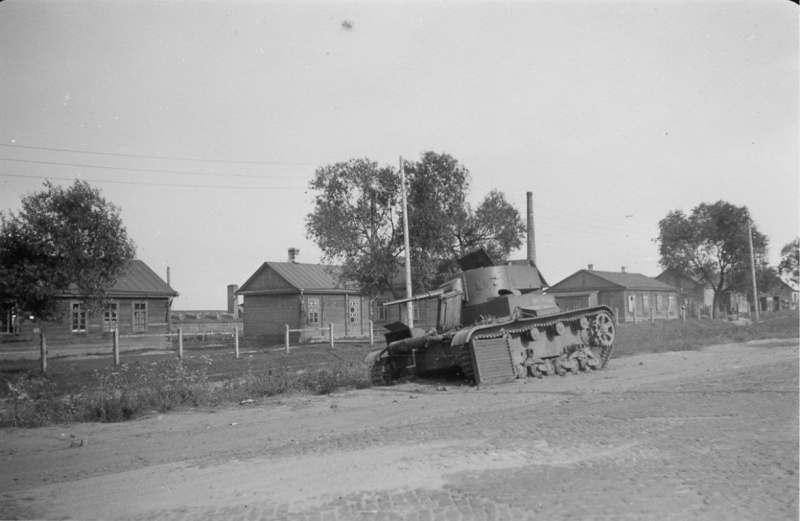
Soviet light tank T-26, thrown on the road in the village due to engine trouble. The crew tried to get tired of the problem and start the engine, but after unsuccessful attempts, I threw the car.
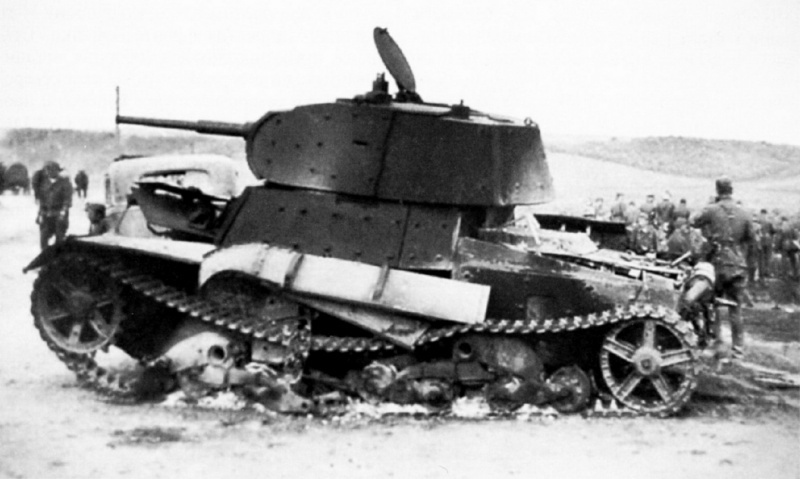
Soviet light shielded tank T-26, destroyed during the fighting in Senno. The tank has a characteristic differences release year 1939-1940 cars. The screening of this type was carried out during the Soviet-Finnish War, somewhat shielded tanks T-26, were a part of the 18th Armored Division of the 7th Mechanized Corps of the Western Front.







